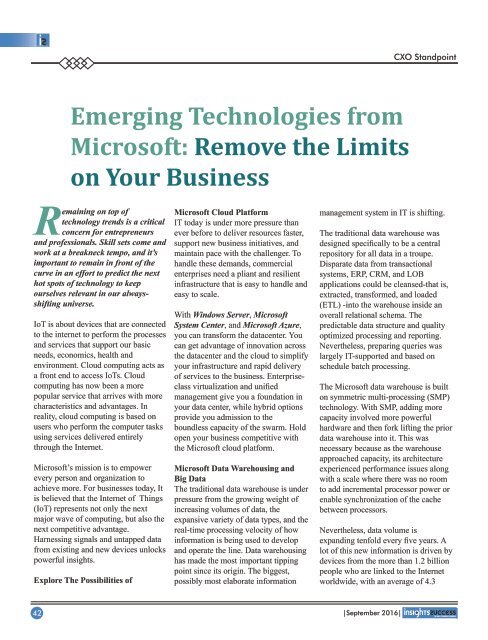Insights Success The 10 Most Valuable Cloud Service Provider Companies
Insights Success The 10 Most Valuable Cloud Service Provider Companies
Insights Success The 10 Most Valuable Cloud Service Provider Companies
Create successful ePaper yourself
Turn your PDF publications into a flip-book with our unique Google optimized e-Paper software.
CXO Standpoint<br />
Emerging Technologies from<br />
Microsoft: Remove the Limits<br />
on Your Business<br />
Remaining on top of<br />
technology trends is a critical<br />
concern for entrepreneurs<br />
and professionals. Skill sets come and<br />
work at a breakneck tempo, and it’s<br />
important to remain in front of the<br />
curve in an effort to predict the next<br />
hot spots of technology to keep<br />
ourselves relevant in our alwaysshifting<br />
universe.<br />
IoT is about devices that are connected<br />
to the internet to perform the processes<br />
and services that support our basic<br />
needs, economics, health and<br />
environment. <strong>Cloud</strong> computing acts as<br />
a front end to access IoTs. <strong>Cloud</strong><br />
computing has now been a more<br />
popular service that arrives with more<br />
characteristics and advantages. In<br />
reality, cloud computing is based on<br />
users who perform the computer tasks<br />
using services delivered entirely<br />
through the Internet.<br />
Microsoft’s mission is to empower<br />
every person and organization to<br />
achieve more. For businesses today, It<br />
is believed that the Internet of Things<br />
(IoT) represents not only the next<br />
major wave of computing, but also the<br />
next competitive advantage.<br />
Harnessing signals and untapped data<br />
from existing and new devices unlocks<br />
powerful insights.<br />
Explore <strong>The</strong> Possibilities of<br />
Microsoft <strong>Cloud</strong> Platform<br />
IT today is under more pressure than<br />
ever before to deliver resources faster,<br />
support new business initiatives, and<br />
maintain pace with the challenger. To<br />
handle these demands, commercial<br />
enterprises need a pliant and resilient<br />
infrastructure that is easy to handle and<br />
easy to scale.<br />
With Windows Server, Microsoft<br />
System Center, and Microsoft Azure,<br />
you can transform the datacenter. You<br />
can get advantage of innovation across<br />
the datacenter and the cloud to simplify<br />
your infrastructure and rapid delivery<br />
of services to the business. Enterpriseclass<br />
virtualization and unified<br />
management give you a foundation in<br />
your data center, while hybrid options<br />
provide you admission to the<br />
boundless capacity of the swarm. Hold<br />
open your business competitive with<br />
the Microsoft cloud platform.<br />
Microsoft Data Warehousing and<br />
Big Data<br />
<strong>The</strong> traditional data warehouse is under<br />
pressure from the growing weight of<br />
increasing volumes of data, the<br />
expansive variety of data types, and the<br />
real-time processing velocity of how<br />
information is being used to develop<br />
and operate the line. Data warehousing<br />
has made the most important tipping<br />
point since its origin. <strong>The</strong> biggest,<br />
possibly most elaborate information<br />
management system in IT is shifting.<br />
<strong>The</strong> traditional data warehouse was<br />
designed specifically to be a central<br />
repository for all data in a troupe.<br />
Disparate data from transactional<br />
systems, ERP, CRM, and LOB<br />
applications could be cleansed-that is,<br />
extracted, transformed, and loaded<br />
(ETL) -into the warehouse inside an<br />
overall relational schema. <strong>The</strong><br />
predictable data structure and quality<br />
optimized processing and reporting.<br />
Nevertheless, preparing queries was<br />
largely IT-supported and based on<br />
schedule batch processing.<br />
<strong>The</strong> Microsoft data warehouse is built<br />
on symmetric multi-processing (SMP)<br />
technology. With SMP, adding more<br />
capacity involved more powerful<br />
hardware and then fork lifting the prior<br />
data warehouse into it. This was<br />
necessary because as the warehouse<br />
approached capacity, its architecture<br />
experienced performance issues along<br />
with a scale where there was no room<br />
to add incremental processor power or<br />
enable synchronization of the cache<br />
between processors.<br />
Nevertheless, data volume is<br />
expanding tenfold every five years. A<br />
lot of this new information is driven by<br />
devices from the more than 1.2 billion<br />
people who are linked to the Internet<br />
worldwide, with an average of 4.3<br />
42<br />
|September 2016|


















